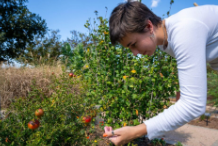As mentioned in a companion article in this newsletter, the best time to overseed cool-season grasses such as tall fescue and Kentucky bluegrass is September because the turf has more time to mature before crabgrass germination in the spring and the heat stress of summer. However, dormant seeding of turfgrass is sometimes used to help fill in bare spots of lawns that weren’t overseeded in the fall. Dormant seeding is normally not used to seed large areas because of the possibility of erosion before the seed emerges and becomes mature enough to hold the soil.
Dormant overseeding is usually done during the winter (December through February) when it is too cold for germination to take place. Spring seedings done in March can be just as successful as dormant seeding, but spring rains may delay plantings. As with any seeding program, it is vital that good seed-soil contact is achieved. There are several methods that are commonly used in dormant seeding.
One method is to seed when there has been a light snowfall of up to an inch over unfrozen soil. This is shallow enough that bare spots can still be seen. Spread seed by hand on areas that need thickening up. As the snow melts it brings the seed into good contact with the soil where it will germinate in the spring.
Another method is dependent on the surface of the soil being moist followed by some freezing weather. As moist soil freezes and thaws, small pockets are formed on the wet, bare soils which are perfect for catching and holding seed. As the soil dries, the pockets collapse and cover the seed.
If dry enough and the soil is unfrozen, seed can be applied to bare spots and then raked in to ensure good seed/soil contact.
With any of the above methods, seed germinates in the spring as early as possible. There will be limitations on what herbicides can be used for weed control. Tupersan (siduron) can be used as a crabgrass preventer on new seedings even before they have come up. Also dithiopyr, found in Hi-Yield Turf and Ornamental Weed & Grass Stopper and Bonide Crabgrass & Weed Preventer, can be used on tall fescue, Kentucky bluegrass, and perennial ryegrass two weeks after germination. Dithiopyr is longer lasting and more effective than siduron. Other preemergence herbicides available to homeowners require that the turf be well established before application.
Ward Upham, Extension Agent




